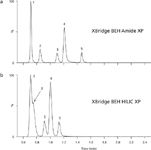Hydrophilic-Interaction Chromatography (HILIC) for LC–MS-MS Analysis of Monoamines using Xbridge BEH Amide XP Columns
Waters Corporation
Introduction
Hydrophilic-interaction chromatography (HILIC) is used for the analysis of monoamine neurotransmitters. Development of the successful chromatographic method depends upon the systematic optimization of organic mobile phase ionic strength to obtain the best peak shape and sensitivity. Choice of stationary phase and column temperature are also important. The resulting method achieves baseline separation for the most polar and challenging analytes in a short analysis time without the use of ion-pairing reagents that are often necessary in reversed-phase analysis of these compounds.
Instrumentation & Consumables
LC Conditions
Instrument: ACQUITY UPLC® System
Column: XBridge™ BEH Amide XP, 2.5 μm; 2.1 × 75 mm
Part number: 186006090
Mobile phase A: 95:5 H2O:ACN w/100 mM NH4HCOO (pH 3.0)
Mobile phase B: 85:15 ACN:H2O w/30 mM NH4HCOO (pH 3.0)
Initial mobile phase conditions were 100% mobile phase A (MPA). The percentage of MPA was increased to 30% over 2.5 min. The percentage of mobile phase B (MPB) was returned to 100% over 0.1 minute and held there for 1.4 min. The flow rate was 0.5 mL/min. The injection volume was 20 μL.
MS Conditions
Instrument: Waters Xevo® TQ-S Mass Spectrometer
Ion Source: ESI+
Results/Discussion
Figure 1a shows the chromatography of the monoamines N-methyl serotonin (NMS), serotonin (5-HT), dopamine (DA) epinephrine (EP) and norepinephrine (NE) analysed on the XBridge BEH Amide XP column. Acceptable peak shape and resolution required using 30 mM NH4HCOO in MPB combined with 15% water to ensure complete miscibility and to prevent phase separation between water and ACN. Lower concentrations of NH4HCOO resulted in poor peak shape. Increasing the aqueous content alone resulted in a predictable decrease in retention for all compounds, but did not result in any improvements in peak shape or resolution between adjacent peaks.

Figure 1: Chromatography of monoamine neutotransmitters on Waters BEH XBridge BEH Amide XP and XBridge BEH HILIC XP columns. Analyte key: 1-NMS, 2-5-HT, 3-DA, 4-EP, 5-NE.
Conclusions
Figure 1b shows chromatograms of monoamine standards analysed on the XBridge BEH HILIC XP column. Clearly, retention of nearly all analytes is superior on the amide column as is the resolution between adjacent peaks. In an acidic environment (pH 3.0), the polar nature of the amide functionality may be more effective at interacting with the aqueous portion of the mobile phase and forming the stagnant water layer required for HILIC chromatography.
These results show that retention, separation and resolution of even the most polar compounds (epinephrine and norepinephrine) can be readily achieved. The combination of particle size (2.5 μm), intermediate length of the column (75 mm) and the relatively low backpressures characteristic of HILIC analyses should afford ample flexibility to adapt this method as needed, allowing either increased throughput, or the ability to run on HPLC systems with limited backpressure capabilities.
For full application note, visit www.waters.com/4389
©2012 Waters Corporation. Waters, The Science of What's Possible, XBridge, ACQUITY UPLC and Xevo are trademarks of Waters Corporation.
Waters Corporation
34 Maple Street Milford, Massachusetts 01757, USA
Tel. +1 508 478 2000 fax +1 508 872 1990
Website: http://www.waters.com

Assessing Thorium-Peptide Interactions Using Hydrophilic Interaction Liquid Chromatography
February 4th 2025Paris-Saclay University scientists used hydrophilic interaction liquid chromatography (HILIC) coupled to electrospray ionization mass spectrometry (ESI-MS) and inductively coupled plasma mass spectrometry (ICP-MS) to assess thorium’s interaction with peptides.

.png&w=3840&q=75)

.png&w=3840&q=75)



.png&w=3840&q=75)



.png&w=3840&q=75)















